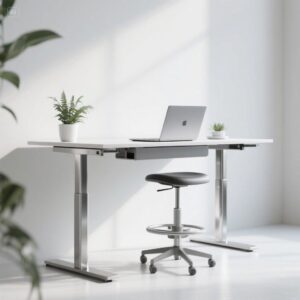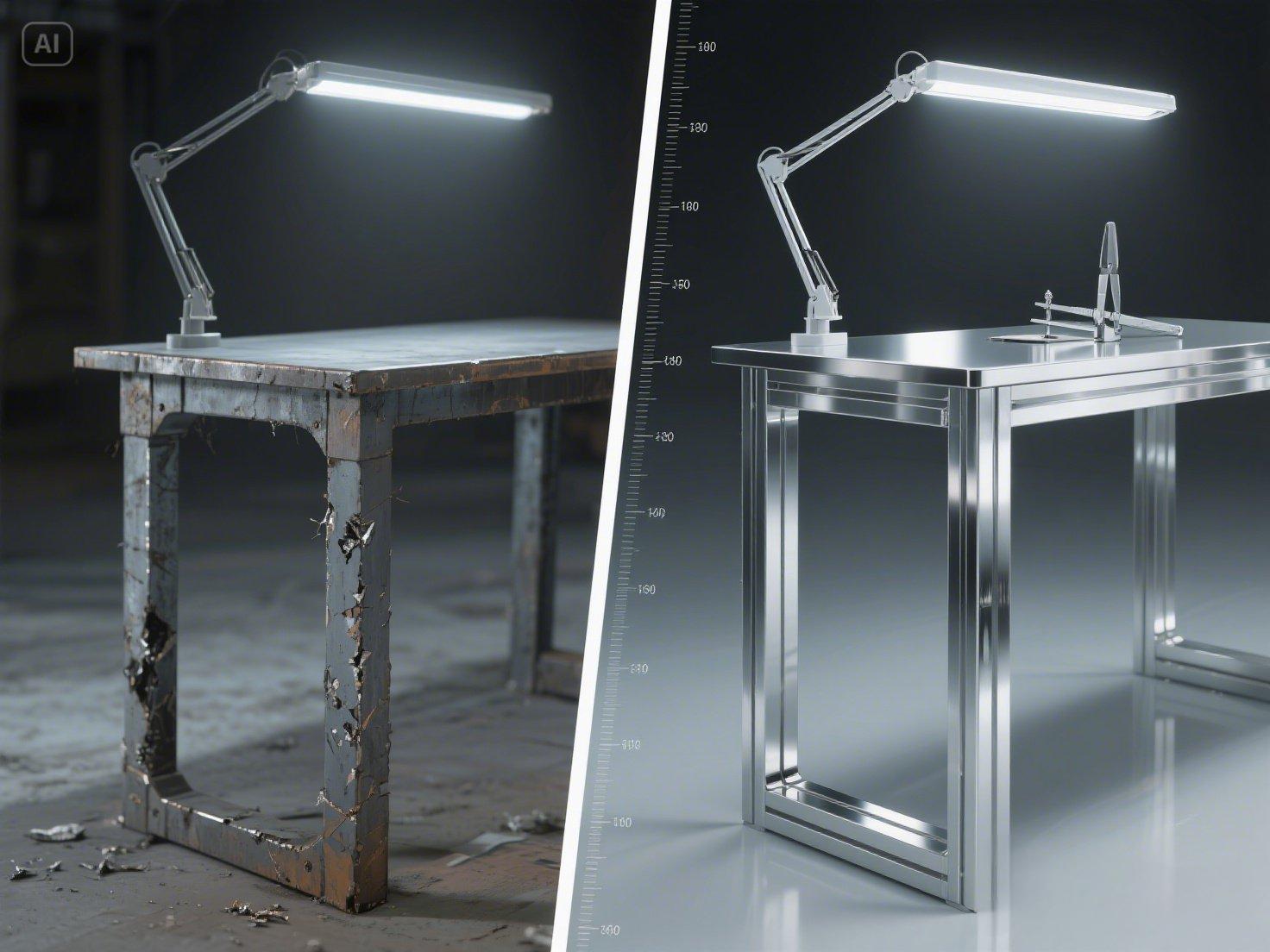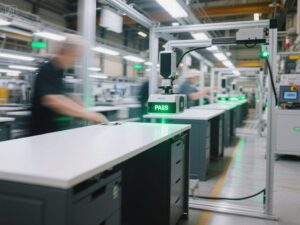I. Introduction
 The modern workspace is evolving, and with it, the demand for ergonomic and adaptable furniture has surged. Sit-stand desks, which allow users to switch between sitting and standing positions effortlessly, have become a staple in contemporary offices and homes. These desks are more than just a trend; they are a response to the growing awareness of the health benefits of movement and the need for flexibility in our workspaces.
The modern workspace is evolving, and with it, the demand for ergonomic and adaptable furniture has surged. Sit-stand desks, which allow users to switch between sitting and standing positions effortlessly, have become a staple in contemporary offices and homes. These desks are more than just a trend; they are a response to the growing awareness of the health benefits of movement and the need for flexibility in our workspaces.At the heart of any sit-stand desk is its frame—a critical component that supports the entire structure and ensures stability and durability. However, what many overlook is the importance of the processes that go into crafting these frames. One such process is polishing, which might seem like a minor step but has a profound impact on the quality and longevity of the desk. In this article, we will explore the role of polishing in desk frame production and why it is essential for both functionality and aesthetics.
II. Definition and Role of Polishing
What is Polishing?
Polishing is a surface treatment process that involves the removal of material through abrasion to achieve a smooth, refined finish. This process can be done manually using sandpaper or mechanically with specialized tools like grinding wheels or belt sanders. The goal of polishing is to enhance the surface quality of materials, whether they are metal, wood, or other composites used in desk frames.
In the context of sit-stand desk production, polishing is not just about making the surface look good; it is a crucial step that prepares the frame for further processing and enhances its overall quality. The process typically involves several stages, starting from coarse abrasion to remove significant imperfections and gradually moving to finer grits to achieve a smooth finish.

The Role of Polishing in Desk Frame Production
Polishing plays a multifaceted role in the production of sit-stand desk frames. Here are some key aspects:
-
Surface Preparation: Before any coating or finishing can be applied, the surface of the desk frame must be free of contaminants, burrs, and imperfections. Polishing removes these unwanted elements, creating a clean and uniform surface. This step is critical because any defect left unattended can compromise the adhesion of subsequent coatings and lead to issues like peeling or uneven finishes.
-
Enhancing Aesthetics: A smooth, polished surface is not only more pleasing to the eye but also more comfortable to touch. In a workspace where users interact with the desk frequently, a polished surface ensures a better tactile experience. Moreover, a high-quality finish adds to the overall visual appeal of the desk, making it a more attractive addition to any office or home environment.
-
Improving Structural Integrity: Polishing can address minor surface defects and irregularities that might otherwise weaken the frame. For instance, sharp edges or rough welds can create stress points that may lead to fractures over time. By smoothing these areas, polishing helps distribute stress more evenly across the frame, enhancing its structural strength and durability.
-
Facilitating Coating Application: Many desk frames undergo coating processes to enhance their durability, corrosion resistance, and appearance. Polishing prepares the surface for these coatings by increasing its roughness at a microscopic level. This roughness, known as surface profile, provides better adhesion for paints, powders, or other protective coatings, ensuring a long-lasting and high-quality finish.
In essence, polishing is not just a cosmetic step in desk frame production; it is a foundational process that enhances both the functional and aesthetic aspects of the product. As we delve deeper into this topic, we will explore the specific benefits of polishing in more detail and understand why it is indispensable in creating high-quality sit-stand desks.
III. Specific Benefits of Polishing for Desk Frames
Polishing is more than just a surface treatment; it is a transformative process that enhances multiple aspects of sit-stand desk frames. Here, we delve into the specific benefits that polishing brings to the production of these essential pieces of furniture.
1. Improving Surface Quality and Aesthetics
 One of the most immediate and noticeable benefits of polishing is the significant improvement in surface quality. The process removes imperfections such as burrs, weld slag, and scratches, which are often left behind during manufacturing. These imperfections not only detract from the desk’s appearance but can also pose risks like sharp edges that might cause injury.
One of the most immediate and noticeable benefits of polishing is the significant improvement in surface quality. The process removes imperfections such as burrs, weld slag, and scratches, which are often left behind during manufacturing. These imperfections not only detract from the desk’s appearance but can also pose risks like sharp edges that might cause injury.By smoothing out these rough areas, polishing creates a surface that is both visually appealing and safe to touch. A polished desk frame exudes a sense of professionalism and quality, making it a more attractive addition to any workspace. Moreover, a smooth surface is easier to clean and maintain, reducing the accumulation of dust and grime over time.
2. Enhancing Coating Adhesion
For sit-stand desks, durability is just as important as aesthetics. Polishing plays a crucial role in ensuring that any protective or decorative coatings applied to the frame adhere properly. The process of polishing creates microscopic roughness on the surface, known as “surface profile.” This roughness provides an ideal base for coatings to bond with the material.
Without proper surface preparation through polishing, coatings may peel or chip off over time, exposing the underlying material to wear and corrosion. By enhancing adhesion, polishing ensures that the coating remains intact, providing long-lasting protection against scratches, stains, and environmental factors. This, in turn, prolongs the lifespan of the desk frame and reduces the need for frequent maintenance or replacement.
3. Repairing Surface Defects
 During the manufacturing process, desk frames may develop minor surface defects such as pits, scratches, or uneven welds. These imperfections can compromise the structural integrity of the frame and affect its overall quality. Polishing is a powerful tool for addressing these issues.
During the manufacturing process, desk frames may develop minor surface defects such as pits, scratches, or uneven welds. These imperfections can compromise the structural integrity of the frame and affect its overall quality. Polishing is a powerful tool for addressing these issues.By carefully removing material from the surface, polishing can fill in small pits and smooth out scratches, creating a uniform and defect-free surface. This not only improves the appearance of the frame but also eliminates potential weak points that could lead to structural failure over time. A polished surface is more resilient and better equipped to withstand the rigors of daily use.
4. Reducing Stress Concentration and Enhancing Structural Strength
Stress concentration is a common issue in metal and composite structures, particularly around welded joints and sharp edges. These areas are prone to developing cracks and fractures under repeated stress, which can compromise the overall strength and stability of the desk frame.
Polishing helps mitigate this risk by smoothing out sharp edges and irregularities, thereby reducing stress concentration. By rounding off corners and creating a more uniform surface, polishing distributes stress more evenly across the frame. This enhances the structural integrity of the desk, making it more durable and reliable for long-term use.
5. Enhancing Product Durability and Corrosion Resistance
In environments where desks are exposed to moisture, chemicals, or frequent use, corrosion and wear can become significant concerns. Polishing plays a vital role in enhancing the durability and corrosion resistance of desk frames.
By removing surface contaminants and oxidation layers, polishing creates a clean and receptive surface for protective coatings. These coatings then act as a barrier against environmental factors, preventing rust, corrosion, and other forms of degradation. This not only extends the lifespan of the desk frame but also reduces maintenance costs and the need for frequent replacements.
IV. Optimization of Polishing Processes
 Polishing is a critical process in the production of sit-stand desk frames, but its effectiveness depends on the optimization of various parameters. Recent advancements in technology and manufacturing techniques have led to significant improvements in the efficiency and quality of polishing processes.
Polishing is a critical process in the production of sit-stand desk frames, but its effectiveness depends on the optimization of various parameters. Recent advancements in technology and manufacturing techniques have led to significant improvements in the efficiency and quality of polishing processes.1. Choosing the Right Polishing Tools
The choice of polishing tools is crucial for achieving the desired surface finish. Common tools include sandpaper, grinding wheels, and robotic polishing systems. For sit-stand desk frames, the selection depends on the material (metal, wood, or composite) and the desired finish. For example, robotic polishing systems can achieve high precision and consistency, especially for complex geometries. These systems use advanced algorithms to optimize the material removal rate (MRR) and ensure a uniform finish.
2. Process Parameter Optimization
Optimizing the polishing process involves fine-tuning parameters such as pressure, speed, and dwell time. Recent studies have shown that using machine learning and simulation can significantly enhance the efficiency of polishing processes. For example, Bayesian optimization techniques combined with deep learning models can optimize the MRR in robotic polishing, leading to faster and more consistent results. This approach not only improves the surface quality but also reduces the time and energy required for polishing.
3. Surface Preparation Before Polishing
Proper surface preparation is essential for achieving optimal results. Before polishing, the desk frame should be cleaned to remove any contaminants, rust, or oxidation. This step ensures that the polishing process is effective and that the final surface is free from imperfections. Proper preparation also helps in achieving a more durable and corrosion-resistant finish.
V. The Impact of Polishing on User Experience and Product Value
 Polishing is not just a manufacturing step; it has a direct impact on the user experience and the overall value of sit-stand desks.
Polishing is not just a manufacturing step; it has a direct impact on the user experience and the overall value of sit-stand desks.1. Enhancing User Experience
A polished desk frame offers a smoother, cleaner surface that is easier to maintain and more comfortable to use. This is particularly important in environments where hygiene is critical, such as medical facilities or food processing areas. Additionally, a high-quality finish enhances the visual appeal of the desk, contributing to a more professional and pleasant workspace.
2. Improving Product Value
Polishing significantly enhances the durability and longevity of sit-stand desk frames. By creating a smoother surface, polishing reduces the risk of corrosion and wear, making the desk more resistant to environmental factors. This not only reduces maintenance costs but also extends the product’s lifespan, adding to its overall value.
Moreover, a polished surface improves the functionality of the desk. For example, smoother surfaces reduce friction, ensuring that moving parts operate more efficiently and with less wear. This is particularly important for sit-stand desks, where mechanical components need to function smoothly for extended periods.
VI. Conclusion
 In summary, polishing is a vital process in the production of sit-stand desk frames, offering far more than just a cosmetic finish. It enhances surface quality, improves coating adhesion, repairs defects, and boosts structural integrity—all of which contribute to a more durable and aesthetically pleasing product. By optimizing polishing techniques and leveraging advanced technologies, manufacturers can significantly elevate the quality and value of their desks.
In summary, polishing is a vital process in the production of sit-stand desk frames, offering far more than just a cosmetic finish. It enhances surface quality, improves coating adhesion, repairs defects, and boosts structural integrity—all of which contribute to a more durable and aesthetically pleasing product. By optimizing polishing techniques and leveraging advanced technologies, manufacturers can significantly elevate the quality and value of their desks.As the demand for high-quality, ergonomic furniture continues to grow, the importance of polishing cannot be overstated. It is a critical step that ensures both functionality and longevity, making it an essential investment for any manufacturer aiming to deliver exceptional products.


